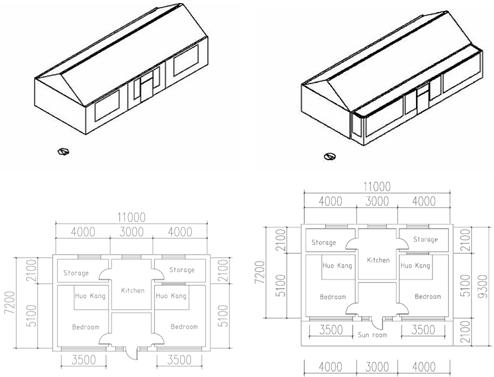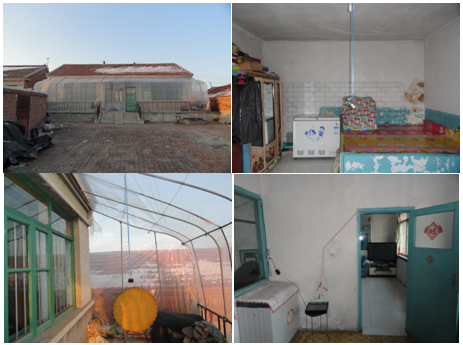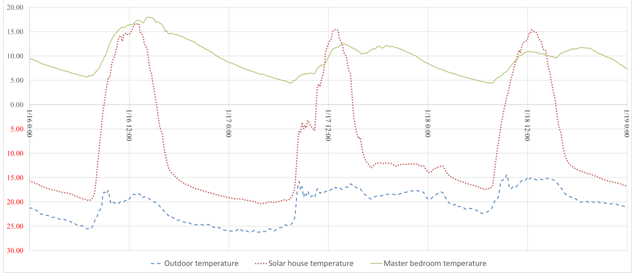ИССЛЕДОВАНИЕ ТЕХНОЛОГИИ НИЗКОУГЛЕРОДИСТОЙ СТРОИТЕЛЬНОЙ МОДЕРНИЗАЦИИ В СЕВЕРО-ВОСТОЧНОМ СЕЛЬСКОМ ОКРУГЕ КИТАЯ С ХОЛОДНЫМ КЛИМАТОМ
Донг К.1, Сун Ченг2
1Докторант, Школа архитектуры, Харбинский технологический институт; Хэйлунцзянская лаборатория по изучению архитектурных строений в холодных регионах, Харбин, Китай, 2Заслуженный профессор школы Чанцзяна, научный консультант, Школа архитектуры, Харбинский технологический институт; Хэйлунцзянская лаборатория по изучению архитектурных строений в холодных регионах, Харбин, Китай
Данная работа выполнена в рамках Национальной программы поддержки науки и техники (грант № 2013BAJ12B04). Данная статья является результатом исследования, проведенного автором во время обучения в докторантуре Харбинского технологического института.
ИССЛЕДОВАНИЕ ТЕХНОЛОГИИ НИЗКОУГЛЕРОДИСТОЙ СТРОИТЕЛЬНОЙ МОДЕРНИЗАЦИИ В СЕВЕРО-ВОСТОЧНОМ СЕЛЬСКОМ ОКРУГЕ КИТАЯ С ХОЛОДНЫМ КЛИМАТОМ
Аннотация
Модернизация существующих зданий рассматривается в качестве одного из основных подходов по обеспечению устойчивости в застраиваемой среде, при относительно низких затратах и высоких коэффициентах поглощения. В исследовании проанализированы существующие здания в холодном сельском районе, исследованы два метода пассивной низкоуглеродистой модернизации, дополнительная пассивная комната на солнечной стороне и увеличение производительности наружной изоляции стен. Используя программное обеспечение DeST-h для сравнения изменения температуры и индекса проектной нагрузки для отопления здания общей модели до и после модернизации, в исследовании представлены три вывода.
Ключевые слова: северо-восточный Китай, холодный сельский район, низкоуглеродистая модификация, симуляционный анализ.
Dong Qi1, Sun Cheng2
1Doctoral Candidate, School of Architecture, Harbin Institute of Technology; Heilongjiang Cold Region Architectural Science Key Laboratory, Harbin, China, 2Distinguished Professor of ChangJiang Scholar, Doctoral Supervisor, School of Architecture, Harbin Institute of Technology; Heilongjiang Cold Region Architectural Science Key Laboratory, Harbin, China
This work is supported by the National Science and Technology Support Program (Grant No. 2013BAJ12B04). It is derived from work undertaken by the corresponding author during PhD studies at Harbin Institute of Technology.
EXPLORATION ON TECHNOLOGY OF LOW-CARBON BUILDING RETROFIT IN NORTHEAST CHINA SEVERE COLD RURAL DISTRICT
Abstract
Retrofitting of existing buildings is being considered as one of the main approaches to achieve sustainability in the built environment at relatively low cost and high uptake rates. According to the analysis on examples at severe cold rural district, the study analyzed two passive low-carbon retrofit methods,additional passive sun room and increase the performance of external wall insulation. By using the DeST-h software to compare the change of the temperature and index of design load for heating of building of the general model before and after the retrofit, this study presented three conclusions.
Keywords: northeast china, severe cold rural district, low-carbon retrofit, simulation analysis.
- Research Background and Objective
In China, almost one half of the population lives in rural areas. They are usually characterized as being ‘‘confronted with economic poverty, with heavy reliance on biomass, leading to damage to ecological environment, etc. [1]’’. Although a wide range of retrofit technologies is readily available, methods to identify the most suitable set of retrofit actions for particular projects are still a major technical and methodological challenge.
The energy saving retrofit of the existing buildings is a long-term work; the Germany spent 18 years to basically complete the construction of energy-saving retrofit mission in East Germany, which is only 1.17% of the total quantity of energy-saving retrofit building of cities and towns in northern china. And because some specific reasons, such as traffic inconvenience, decline of living conditions, extreme winter cold living environment, especially the young people, wealthy people gradually leave the countryside, the retrofit construction in northeast china has greater challenges and opportunities. With the revitalization and development of the northeast old industrial bases, the rising of rural construction, the energy saving design and the energy efficient retrofit will always be one of a next hot study spot.
Dong Haiguang [2] based on a field investigation of the structure and heating energy consumption in winter of rural houses in northern china, proposed that external wall with a thickness of 50- 60mm of polystyrene board insulation can reach the best energy efficiency, and additional sun room can reach 15.4% of the heating energy saving rate.
Niu Tiancai [3] analysis the thermal environment and energy saving problem of the new rural housing retrofit construction in the Zhidan village of Shanxi Province, discovered that the retaining structure has a significant effect on building thermal performance, and sun room can increase the thermal comfort of the room in the south as well as reducing the heat load in winter, saving energy about 15%.
- Method
2.1. Basic reference model
According to the field study, SongYuan city belonging the severe cold (C) region, the rural housing’s windows is ordinary double plastic window, the walls are mostly brick structure, the roof is the traditional gable roof. Due to the poor insulation performance, the poor indoor thermal comfort, and high energy consumption for heating, the fuel for heating are wasted. Aiming at this situation, by using DeST-h simulation software, this study analysis two energy-saving programs which are currently widely used, increase wall insulation performance and add sun room in the south.
As shown in the Figure 1, the typical model of rural building in SongYuan City is single-story residence, the length is 11.0m, the width is 7.2m, the roof slope angle is 45°, north-south orientation, the building area is 79.2㎡. Each part of the structure of the reference model is shown in table 1.

Fig. 1 – The Floor Plan and Perspective of the Reference Model
Table 1 – Each part of the structure of the reference model
| Place | Structure |
| External wall | 370 mm clay brick masonry, 20 mm cement mortar plaster inside and outside |
| Internal wall | 240 mm clay brick masonry, 20 mm cement mortar plaster inside and outside |
| Roof | Traditional double slope roof, 15mm watts + 50mm grass mud + 30mm reed |
| Door | single wooden swing doors, entrance doors 1.5m*2.1m |
| Window | The bedroom window 3.5m*2.1m, common 3mm steel window double glass spacing 250mm; foyer outside window ordinary 3mm glass single steel window |
2.2. The field testing results
According to the measured data (figure 2), this study chooses four days date of the all seven days to calculate, which is showed in the figure 3.

Fig. 2 – The field study rural house

Fig. 3 – The measured data of the typical rural house
The maximum outdoor temperature is -13.63℃, the lowest temperature is -26.13℃, the average temperature is -19.82℃; the maximum bedroom temperature is 16.42℃, the lowest temperature is 4.26℃, the average temperature is 9.30℃; the maximum sun room temperature is 15.00℃, the lowest temperature is -21.00℃, the average temperature is -9.20℃. The bedroom, sun room and outdoor temperature change along with the outdoor temperature change, and all the maximum temperature occurred at noon time.
According to the design standard for energy efficiency of rural residential buildings(GB/T50824-2013), the basic calculation winter indoor temperature (with heating) is 14℃, the basic calculated winter temperature (without heating) is 8℃. According to the research and testing, the indoor thermal comfort of the most of the rural residential buildings is still hard, though the occupants made the affordable heating measures. At present, more and more occupants through adding thermal insulation materials to the external wall, or attached sun room in the south.
Zhang Qun [4] made qualitative analysis on these two retrofit methods, but no agree on which one is the better. Xu Junfang [5] based on thermal test data of enclosure structure before and after energy saving reformation of rural residential buildings in Beijing, through the theoretical analysis and numerical simulation, proposed the most obvious energy saving method is the window rebuilding. And if fund is limited, the rebuilding method shall be selected according to the following sequence, such as external window, external wall and roof.
2.3 The study on the technology of low-carbon building retrofit
This study from the perspective of quantitative, use the DeST-h software developed by Tsinghua University, simulate the whole year space heating loads before and after retrofit, which is aimed to find the merits and demerits of the two plans. The table 2 showed the special structure of the plans.
Table2 – Special structure of the plans
| Retrofit plan | The detailed structure |
| Wall insulation | 80 mm eps thermal insulation on external wall, and put 20 mm cement mortar on the surface |
| Additional sun room | Add sun room in the south: with eaves high, single ordinary 3 mm glass steel window on the 80 cm high of the 120mm bricks, 6mm common glass roof, single wood door |
Because the Kang, Hot Wall, cook stoves cooking, and other unconventional heating equipment and heating sources cannot be effective measurement, so the simulation proceed does not consider the heat impact of the above unconventional heat sources. According to the living habits of local farmers, this study proposed the special simulation parameters.
- Results and Discussion
3.1. Results
The results of the simulation demonstrate that the total annual heat load indicator is 120KW·h/㎡, the heat load indicator of heating season is 32W/㎡, which is far greater than the predetermined indicator 24.2W/㎡ of Song Yuan city. So, we must take refurbishment measures.
According to the different retrofit plans, we made different simulation results. As shown in the table 3, the external wall insulation can improve all the indoor room temperature. The bedroom 1 and bedroom 2 average raised 4.66℃ than the former, the kitchen average raised 3.64℃, the hall average raised 2.48℃, and the south side rooms remained not change.
However additional sun room only improve the hall temperature by 1.34℃, while the bedroom 1 and bedroom 2 decreased 1.24℃, the diurnal temperature fluctuations on the south side of the room is weakened.
Table3 – The average temperature change of the room before and after retrofit
| Item | Outdoor | Bedroom 1 | Bedroom 2 | Kitchen | Hall | Sun room |
| Reference room | - | -2.02 | -1.98 | -2.76 | -2.86 | -- |
| wall insulation | -19.19 | 2.45 | 2.47 | 0.88 | 0.38 | -- |
| sun room | - | -3.08 | -3.03 | -4.00 | -1.52 | -4.04 |
3.2. Discussion
Based on the above analysis we can see that external insulation retrofit can effectively enhance the overall performance of building insulation and reduce residential heating load which use double cold steel window.
Despite the sun room’s large windows can increase the ability to collect solar heat, the single-glazing heat transfer coefficient shortcomings make a larger portion of the collected heat loss to the outside space, and only very small part of the incoming heat can transfer by the double steel windows into the bedroom. And the sun room directly reduces the ability of the south bedroom to obtain direct solar radiation. So, the sun room only can reduce the hall heating load, while the efficiency to reduce the whole building heating load is poor. So this type of energy-saving houses in rural areas is not suitable for adding sun room, while can use the way for exterior wall insulation. Through the whole year residential load statistical analysis, external wall insulation can achieve energy-saving heating rate 31.52%, while additional sun room can only achieve 6.59%.
- Conclusions
(1) After adding sun room, the temperatures in the bedroom and kitchen reduced, the temperature in the hall increased, the overall heating energy-saving rate of the building is only 15.54%.
(2) The external wall thermal insulation mode (80mm EPS) can effectively in-crease the temperatures in these rooms, and reduce the heat load for heating, the heating energy saving rate is 31.99%.
(3) The energy saving renovation for rural residences using double steel windows in the cold areas is not fit with adding passive sun room, is fit with the method of external wall thermal insulation.
Список литературы / References
- Zhang L.X. Rural Energy in China: Pattern and Policy / LX. Zhang, ZF. Yang, B. Chen // Renewable Energy. – 2009. - № 12. – P. 2813–2823. doi: 10.1016/j.renene.2009.04.006
- Dong H.G. Heating Energy Simulation and Energy Saving-analysis of Typical Rural House in Northern China Areas / H.G. Dong, S.H. Xu // Journal of Beijing University of Civil Engineering and Architecture. – 2010. - № 3. – P. 42–46. doi: 10.3969/j.issn.1004-6011.2010.03.010
- Niu T.C. The Simulation Analysis on the Rural Construction of Residential Rehabilitation Programs in Shanbei s / TC. Niu, Y.L. Ma // Science & Technology Information. – 2011. - № 21. – P. 759. doi: 10.3969/j.issn.1001-9960.2011.21.263
- Zhang Q. Practice and thermal environment analysis of passive solar house for rural areas in Ningxia. / Q. Zhang, R. Liang, J.P. Liu // Journal of Xi'an University of Science and Technology. – 2011. - № 2. – P. 172-176. doi: 10.3969/j.issn.1672-9315.2011.02.010
- Xu J.F. Numerical simulation and analysis on economic efficiency of energy Saving reformation of rural residential building. / J.F. Xu, X. Tian, L. Liang Liu // Architecture Technology. – 2011. - № 10. – P. 890-892. doi: 10.3969/j.issn.1000-4726.2011.10.007.
